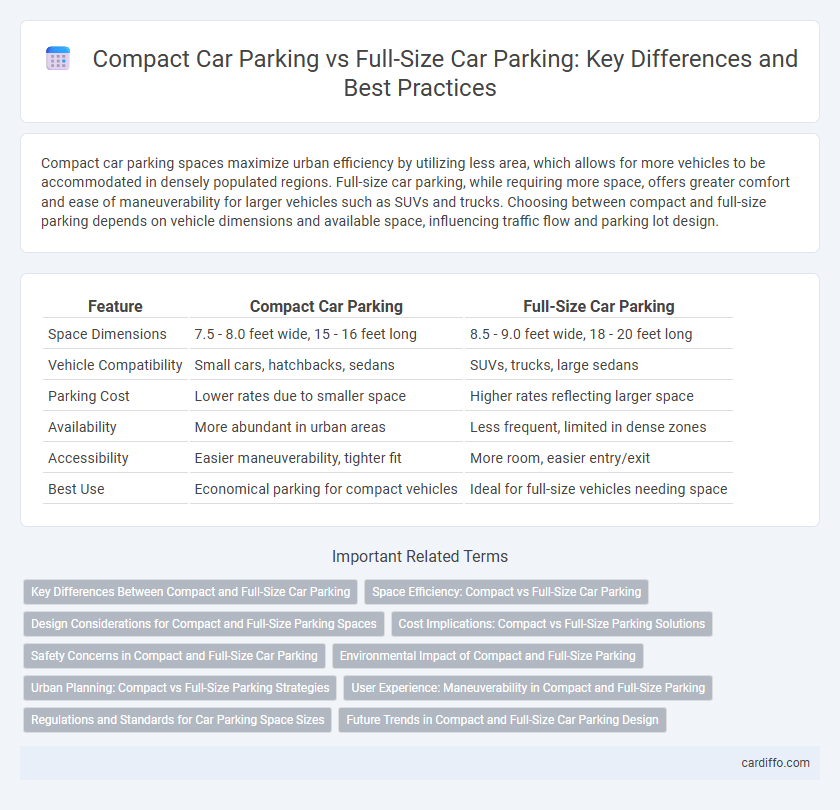Compact car parking spaces maximize urban efficiency by utilizing less area, which allows for more vehicles to be accommodated in densely populated regions. Full-size car parking, while requiring more space, offers greater comfort and ease of maneuverability for larger vehicles such as SUVs and trucks. Choosing between compact and full-size parking depends on vehicle dimensions and available space, influencing traffic flow and parking lot design.
Table of Comparison
| Feature | Compact Car Parking | Full-Size Car Parking |
|---|---|---|
| Space Dimensions | 7.5 - 8.0 feet wide, 15 - 16 feet long | 8.5 - 9.0 feet wide, 18 - 20 feet long |
| Vehicle Compatibility | Small cars, hatchbacks, sedans | SUVs, trucks, large sedans |
| Parking Cost | Lower rates due to smaller space | Higher rates reflecting larger space |
| Availability | More abundant in urban areas | Less frequent, limited in dense zones |
| Accessibility | Easier maneuverability, tighter fit | More room, easier entry/exit |
| Best Use | Economical parking for compact vehicles | Ideal for full-size vehicles needing space |
Key Differences Between Compact and Full-Size Car Parking
Compact car parking spaces typically measure around 7.5 to 8 feet wide and 15 to 16 feet long, designed to accommodate smaller vehicles efficiently. Full-size car parking spaces are larger, often about 9 to 10 feet wide and 18 to 20 feet long, providing extra room for bigger vehicles such as SUVs and trucks. The key differences include space allocation, maneuverability, and suitability, with compact spaces maximizing parking density while full-size spaces ensure easier access and reduce the risk of damage for larger vehicles.
Space Efficiency: Compact vs Full-Size Car Parking
Compact car parking maximizes space efficiency by requiring significantly less area per vehicle, allowing parking lots to accommodate more cars within the same footprint compared to full-size car spaces. Full-size car parking demands wider and longer spots, reducing the total number of vehicles that can be parked and increasing overall land use. Urban areas and high-density parking facilities prioritize compact spaces to optimize capacity and minimize economic and environmental costs.
Design Considerations for Compact and Full-Size Parking Spaces
Compact car parking spaces typically measure 7 to 8 feet wide and 15 to 16 feet long, optimizing limited urban areas and maximizing lot capacity, while full-size car parking spaces range from 8.5 to 9 feet wide and 18 to 20 feet long to accommodate larger vehicles comfortably. Design considerations for compact parking emphasize efficient space utilization, effective vehicle maneuverability, and clear signage to prevent congestion, whereas full-size parking prioritizes ease of entry and exit, additional clearance for SUVs and trucks, and enhanced accessibility features. Proper dimensioning and strategic layout planning in both types ensure safety, convenience, and optimal usage tailored to vehicle size distinctions.
Cost Implications: Compact vs Full-Size Parking Solutions
Compact car parking spaces typically require less area, translating into lower construction and maintenance costs compared to full-size car parking solutions. Full-size parking spaces demand more extensive infrastructure, which increases expenses related to land usage, materials, and upkeep. Choosing compact car parking can optimize budget efficiency, especially in urban areas where space and cost constraints are significant.
Safety Concerns in Compact and Full-Size Car Parking
Compact car parking spaces often provide less room for vehicle maneuvering, increasing the risk of door dings and minor collisions, especially in crowded parking lots. Full-size car parking offers more space, which can reduce accidental contact and improve driver visibility, enhancing overall safety. Safety concerns in both types emphasize the need for adequate space and clear markings to prevent damage and ensure pedestrian protection.
Environmental Impact of Compact and Full-Size Parking
Compact car parking reduces the environmental footprint by requiring less paved surface area, decreasing stormwater runoff and heat island effects compared to full-size car parking. Full-size parking lots demand more land, leading to greater habitat disruption and increased carbon emissions from construction materials and maintenance. Choosing compact car spaces supports sustainable urban design by minimizing resource consumption and promoting efficient land use.
Urban Planning: Compact vs Full-Size Parking Strategies
Urban planning integrates compact car parking by maximizing space efficiency in densely populated areas, allowing more vehicles within constrained zones. Full-size car parking strategies prioritize accessibility and comfort, often requiring larger lot dimensions and impacting land use allocations. Balancing these approaches supports sustainable urban mobility, reduces congestion, and optimizes parking infrastructure cost-effectiveness.
User Experience: Maneuverability in Compact and Full-Size Parking
Compact car parking offers enhanced maneuverability due to tighter spaces designed for smaller vehicles, reducing the effort required for parking and exiting. Full-size car parking accommodates larger vehicles but often limits ease of movement, increasing the risk of minor collisions or difficulty in alignment. User experience improves in compact parking by minimizing blind spots and allowing smoother turns, which is critical in crowded urban environments.
Regulations and Standards for Car Parking Space Sizes
Regulations and standards for car parking space sizes vary to accommodate compact and full-size vehicles, with most jurisdictions setting compact spaces around 7.5 to 8 feet wide and 15 to 16 feet long, while full-size spaces typically measure 8.5 to 9 feet wide and 18 to 20 feet long. The Americans with Disabilities Act (ADA) and local zoning laws often dictate minimum dimensions, ensuring safe maneuverability and accessibility. Designing parking areas requires adherence to these standards to maximize space efficiency, comply with safety codes, and reduce damage risks for different vehicle sizes.
Future Trends in Compact and Full-Size Car Parking Design
Future trends in compact and full-size car parking design emphasize maximizing space efficiency through smart technologies and adaptive layouts that accommodate diverse vehicle dimensions. Integration of automated parking systems and sensor-based guidance improves utilization rates and reduces congestion in urban environments. Sustainable materials and energy-efficient lighting are increasingly adopted to create eco-friendly parking facilities catering to both compact and full-size vehicles.
Compact car parking vs Full-size car parking Infographic

 cardiffo.com
cardiffo.com